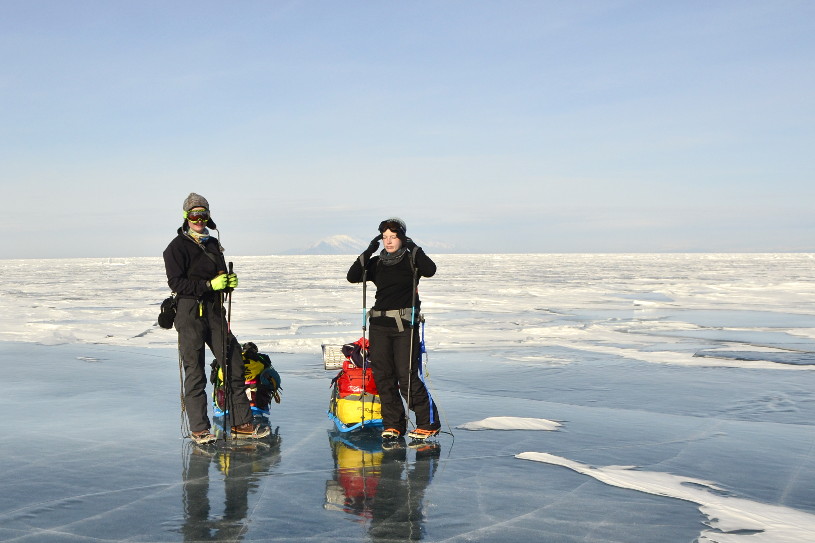
I started this website to help people go on adventures. I use three means to do so:
- Giving advice
- Giving money
- Demonstrating that expeditions don’t always need lots of time, money and expertise
The article I am posting today reassures me that #3 is working.
In 2009, I was part of a group that made several first ascents in the Russian Altai mountains. We wanted to show that it was possible to climb new mountains within two weeks’ annual leave and many groups have since contacted me about climbing there. Like these guys.
In 2011, Laura and I crossed the tiny Wahiba Sands desert on foot. It took three days, required very little equipment and cost about £50. I was delighted when a young group contacted me a few years later to say they wanted to undertake a similar crossing. They succeeded.
In 2017, Laura and I crossed frozen Lake Baikal in Siberia. It was like a miniature polar expedition, camping on ice and melting snow for water. But unlike a real polar trip, we did this one on annual leave for less than £1,000. Later that year, I met three women who had heard about our trip and were interested in doing something similar.
This is how they got on…
[one_sixth]–[/one_sixth]
[two_third][box]
The Next Challenge Grant
Kathryn, Ellie & Theresa’a trip was supported by The Next Challenge Grant, an annual bursary for aspiring adventurers.
It’s funded by me – Tim Moss – several other adventurers and crowdfunded public donations.
Since 2015 it has supported 50 different expeditions with awards from £50 to £800.
[/box][/two_third]
[one_sixth_last]–[/one_sixth_last]
Crossing Lake Baikal in Winter
A first cold weather expedition – with someone you found on Facebook
by Kathryn Bennett
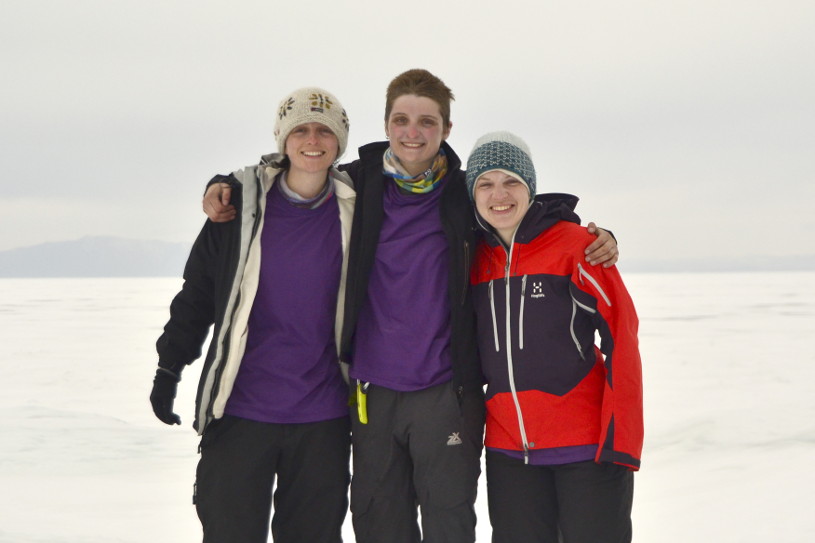
At the start of this year, myself and a friend saw a post on the Love Her Wild Facebook group, about someone looking for partners to fill some spaces on an adventure. Six weeks later, we set out to cross the ice of Lake Baikal in Siberia on the wildest adventure of my life so far.
Theresa had met Tim Moss from The Next Challenge at the RGS Explore weekend, got chatting to him about his 2017 expedition to cross Lake Baikal in winter with his wife Laura, and was instantly struck by the idea. She spent the next few months planning her own version: she and some friends would make a roughly 60km crossing from West to East across the deepest part of the lake.
Theresa’s friends ended up unable to make it, but she put the message out there and posted a request for some willing adventurers on social media. Ellie saw it, tagged me, and after some consideration, we leapt at the opportunity.
If I’m honest, Siberia had escaped my list of dream destinations before this trip. But it quickly became apparent that this adventure ticked all the right boxes for what I’d been looking to do in 2018: it was a venture into a true wilderness, it was a challenge to be completed, and it was the chance to do it all whilst amongst a different culture. It was also a great first foray into extreme conditions – sub-zero temperatures, a remote location and likely adverse situations.
Doing something like this, last minute with someone you’ve only just met is both an incredible experience and one which can teach you a lot about both adventuring and yourself. Here are the main things myself and the team have taken away, and what we learnt about completing a crossing of Siberia’s Lake Baikal in winter.
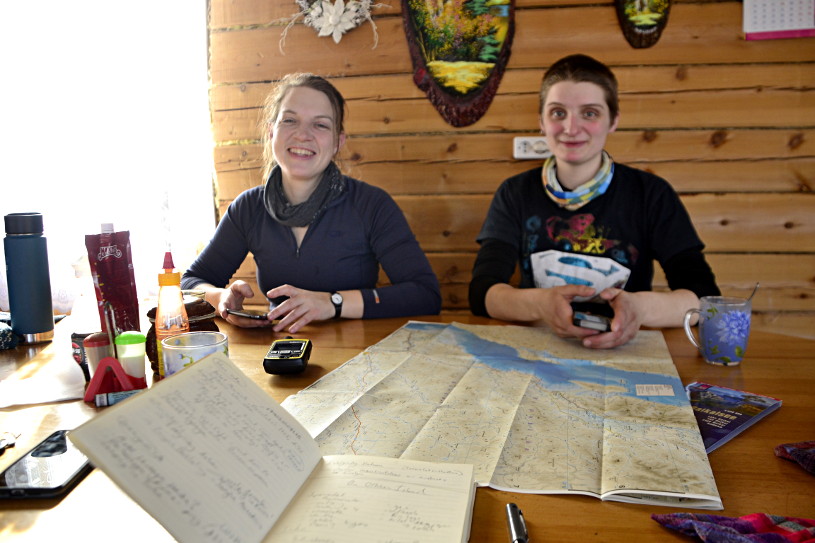
1. Pulling an expedition together as a group of novices is possible – and you can do it in 6 weeks
6 weeks isn’t strictly accurate. This was myself and Ellie’s timeframe; Theresa of course had planned the trip before we were on board, which made things much easier. But putting together the rest was still a big job for a trip in less than two months’ time, and even more so because as far as going on an expedition was concerned, we were starting from nearly scratch in both gear and knowledge.
The two things I took away from this are: you have more than you think, and if you don’t, someone else does. The outdoor industry is full of people looking to help fellow members of the community on their next adventure. We asked friends, acquaintances and numerous Facebook groups, and were not disappointed.
Here’s a basic list of things between us we were given or lent:
- Merino thermals
- Buffalo jacket
- Sub-zero down sleeping bags
- MANY gloves and mitts
- Down booties
- Down jacket
- Waterproof thermal walking trousers
- Trekking poles
- Micro-spikes
- Inverted gas stove [this is a stove that has a “pre-heat tube” so you can use it at lower temperatures – Tim]
- Ski googles
- Balaclavas and buff
Advice and knowledge was equally accessible based on the same principle. From Tim and Laura Moss taking the time to answer all our questions about their previous version of this expedition, to friends with more experience of similar conditions, most of our questions and concerns were answered before going by a pool of like minded folk more than happy to help. I can’t wait to pass it forward one day.
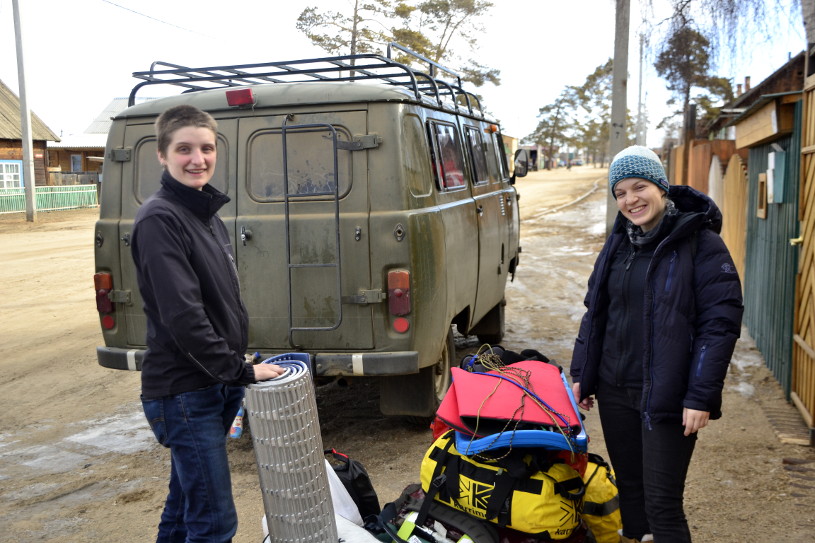
2. Going on an adventure with a stranger is pretty awesome
Going on a trip like this with someone you hadn’t met before sounds intimidating, but all it requires is prep. In the initial stages Ellie met up with Theresa in London to check she was, in fact, a real person, and to talk about the trip. After we’d committed to going, we met up in the Yorkshire Dales for a practice wildcamp and bonding session on the moors. With conveniently sub-zero temperatures due to the arrival of the Beast from the East, we got to know each other as we learnt to put up our new four-season tent, cooking dinner together and chatting into the night.
This also meant we could go through everything we thought we’d need to know – how to tell if one of us was feeling cold, tired or hungry, any concerns we had, and a range of practical problems we still hadn’t worked out about the trip, such as emergency contingencies and the challenges we’d face on the ice. By the end of that weekend we had covered a lot of things, and by the end of the expedition, we’d formed solid friendships. Ultimately, open-minded individuals interested in the same things are bound to work well together, and it was fantastic meeting someone from a completely different walk of life, bonding through a shared passion and life-changing experience. Two weeks after our meet, we flew out to Siberia.
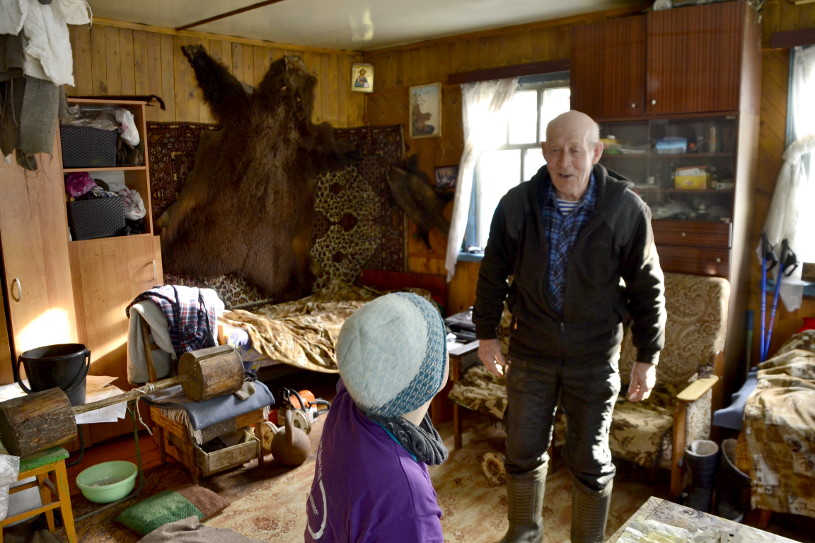
3. The locals will have many, many opinions about what you’re doing
We hit our first hurdle essentially the minute we landed in Irkutsk. The plan was to get supplies, complete a test camp to check equipment and then transfer to our crossing point the following day. Before we did that, we wanted to register our crossing with Baikal’s emergency services.
Laughter, shock and horror ensued; both the hostel owner helping us translate and the emergency officer (female, interestingly) thought it was hilarious we would be attempting this without a man in the group – or leading the expedition. This was the first time we heard what became the catchphrase of the trip: ‘Three women? Really? Without a man?’
Once the ridicule had died down, they expressed their more pressing concerns: the region was unseasonably warm, and two days before our arrival, the fault-line forming Baikal had let loose and the area had suffered a minor earthquake – not enough to cause damage but strong enough to raise concerns about the quality of the ice. We sat stunned – naively, whilst we’d spent time prepping for things going wrong, we had been so focused on our goal and trusting in the infallibility of Baikal’s famous winter we had not really considered that the ice itself might not be safe enough to set foot on in the first place.
It’s amazing that whilst you over prepare for some things, other problems arise that you won’t even have considered. Whilst we had 3 different stoves and finding gas for them was relatively simple for example, we very nearly were unable to find sledges to make pulks from. Theresa and Ellie spent an entire afternoon searching the city – apparently we were there just a little too late in the season for there to be some stocked. Fortunately they managed to find probably the last 3 sledges in the entirety of Irkutsk – it would have made our lives a lot harder if they hadn’t.
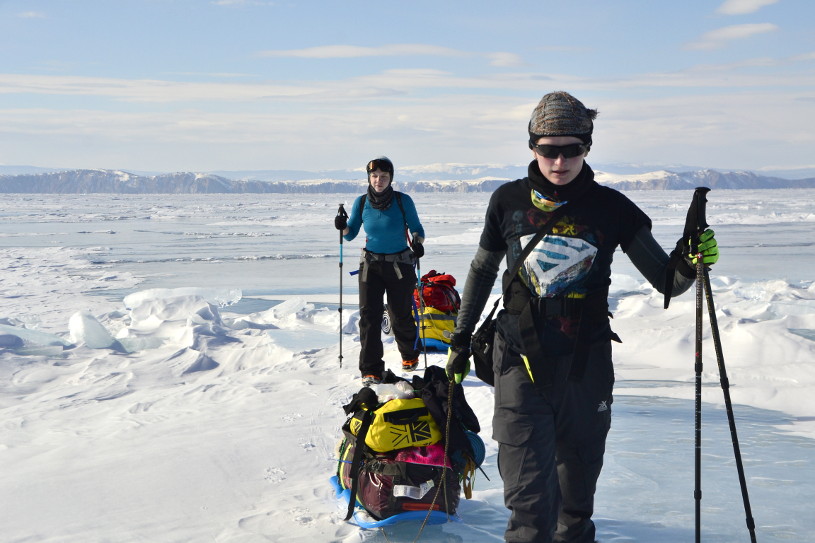
4. Trust your and your team’s ability to make decisions
After we had decided to push ahead to Olkhon Island, our planned departure point, to investigate further, we spent the next three days continuing with our prep whilst making numerous phone calls, with our valiant translator Theresa trying to keep track of everything that was being thrown at us. It was a tense period of highs and lows, and tested our resolve as a group beyond anything we had expected.
By the time we reached the ice, we’d heard all the warnings you could possibly think of: the ice was too thin, the earthquake had caused cracks, there was a storm coming in, there were wolves near the shore, and – our personal favourite – we’d fall into holes in the ice caused by the seals coming up for air. In some ways, this was all a testament to how helpful and welcoming the local people are here – I believe we definitely fell victim to a lot of maternal worry from mothers in the area.
It was a swift lesson in being confident in our own research and opinions, and by the time we had spoken to several sources including an expedition service we trusted, who recommended to us that conditions would be fine, we felt we had done enough research to know it was safe to proceed.
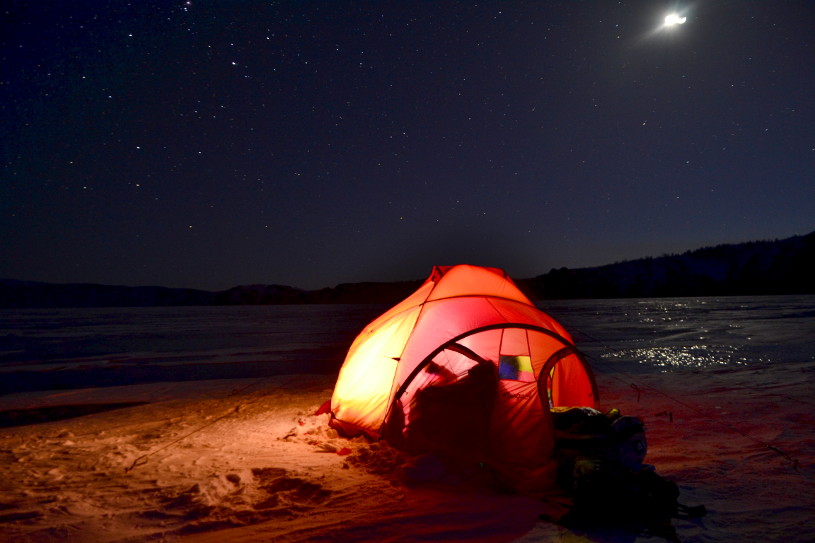
5. No matter how much you prepare, it’s probably going to get a bit scary
One painstakingly slow and rickety sightseeing ride in a rusty old Russian bukhanka (ex-USSR off-road van) later, and we were at our starting point at the end of Olkhon Island. Tourists and locals alike were bemused and intrigued as they abandoned us on the ice, all demanding photos of the moment of our departure. The moment we started our trek and strode out across the ice, laden pulks in tow, felt pretty special. After the stress of making our decision, we were buoyed by committing to the challenge and made good headway to our first camp. With the ice screws in, tent erect, stove melting snow for water and dehydrated meals cooking away in their packs, we were ecstatic to have set off and looking forward to our first full day of walking. But it was over dinner that we began to hear our first gunshots.
A quote from one of our guidebooks had spoken of the immense body of water we were trekking across, commenting that ‘living Baikal breathes’. Well, as Ellie said, it turns out she does, and she does it rather loudly. Whilst we had been warned we’d be able to hear the ice, nothing can quite prepare you for the sheer volume of cracks echoing across the sky, bubbles of ice popping in the depths and the groaning of plates slowly grinding and straining against each other as the temperatures drop at dusk. We crawled into our tent and settled uneasily into our bags, feeling like the ice would open and Baikal would swallow us whilst we slept.
Funnily enough, it didn’t, and we woke the next morning to find a hairline crack underneath our tent. In a bizarre way, this allayed our concerns, as if even a tiny crack caused such a cacophony, we’d always be warned of what was happening with the ice.
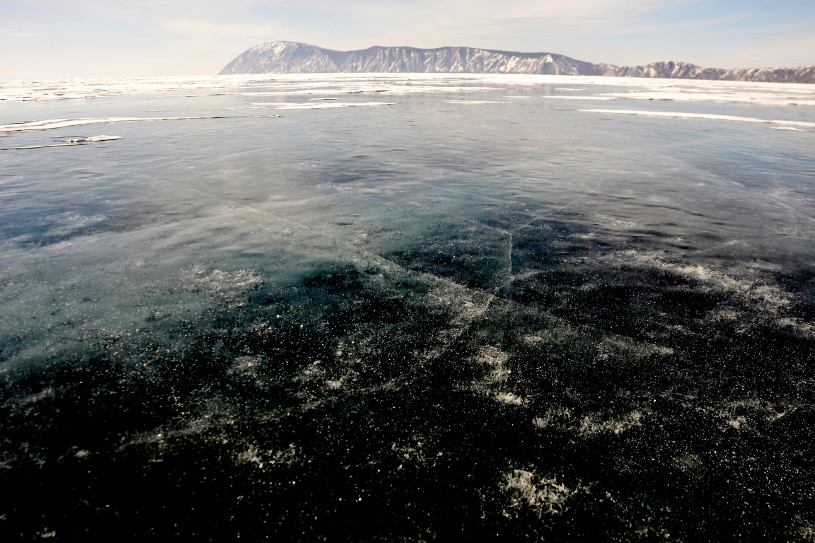
6. Success can have different definitions – go through them before you set off
The next couple of days were simply some of the most beautiful I’ve ever experienced so far on my adventures. We strode on over the kilometres of ice and snow watching the frozen formations constantly change underneath. Time seemed to condense, and it would feel like we’d barely spent any time walking before we were looking for a patch of snow to swiftly set up camp for the night before temperatures dropped.
Our biggest obstacle came when we were roughly 40km into the crossing. An ominous crack appeared on the horizon, and on reaching it we discovered a significant gap about a metre across in the ice, the sun reflecting off the water welling up in between. It stretched as far as the eye could see in either direction and we had a tough choice – commit to walking around it, which could put us hours, even days off route, or attempt to cross it, something we’d been specifically advised not to do. Where we had reached it, there was even a patch of ice and snow seemingly bridging the gap – all too tempting.
So here’s where I’m going to be honest. This caused a fair bit of tension. We were caught, with different team members pushing for different ways forward, between crossing the crack and completing the route we had plotted, or not taking the risk and coming off the lake at an unknown, unplanned location. There was even the chance the crack could extend for literal miles, meaning we could walk for hours or end up far, far from where we wanted to be. But when it came down to it, there were clear factors which made our choice for us.
The first was that whilst we had prepared as much a possible, none of us were experts in this environment and there was no telling what the ice was doing on either side. Second, whilst the detour could add days onto our walk, we had extra provisions for exactly that eventuality, so risking the crossing made no sense. Third and most important, if any member of our group didn’t want to cross, then the option was off the table. So we started walking.
Three hours walking later, we reached the source of the crack. With new energy we put good distance between ourselves and this beast of an obstacle and worked out a new plan.
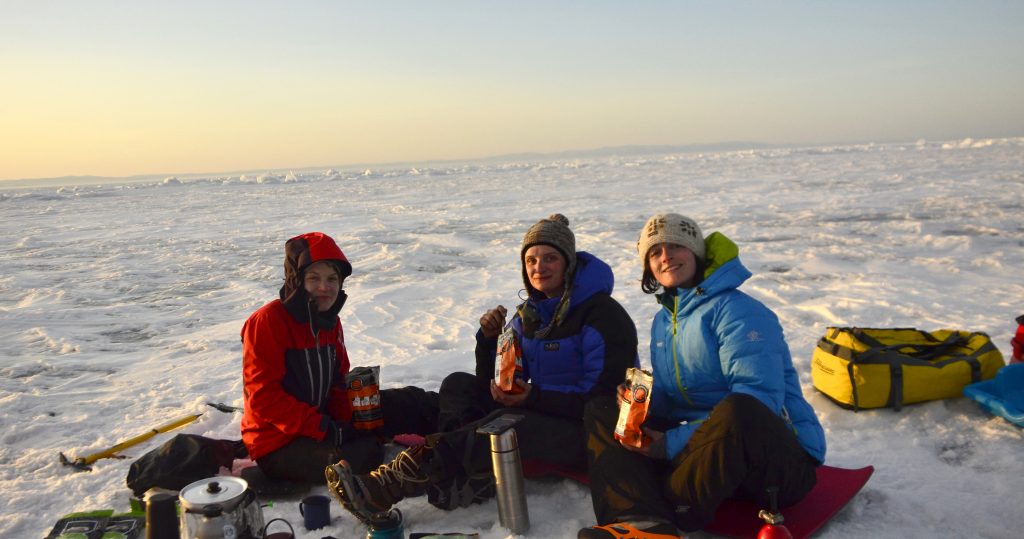
7. Sometime the best place to be is the one you didn’t plan on reaching
We came off the ice a day later at midday. The night before we had worked out the best place to come off was a small settlement on the map, with tracks by the lake so we could reach the road and try hitch a ride to the nearest town. It was surreal dragging our loads up a snowy drift onto the little peninsula we’d been staring at for miles. For all of us, and especially Theresa, who had been planning this epic adventure for so long, it was barely comprehensible. We’d actually made it across Lake Baikal.
But, we were still in the middle of Siberia, currently without a way to reach the place we needed to get to for the night. The afternoon that followed was one of my favourite memories of the trip.
From the peninsula, we needed to reach the nearest track. What we hadn’t anticipated was an immense volume of snow, caught between the rocky outcrop and the shore. This was the slowest section of the entire crossing, as we waded through metre deep dense drifts. It was miserable. Our pulks were constantly tipping into the snow over uneven ground and causing us to fall face-first into the snow.
When we reached the settlement, soaked, we discovered we’d had an audience watch us battle against the final challenge of Baikal with a fair amount of amusement. As we wound our way up tracks to find the road, an elderly local appeared and directed us to the highway. Whilst he was confused by our appearance, he nonetheless asked Theresa if we’d come in for some tea. We were unwilling to pass up on such a unique experience and accepted, soon finding ourselves in a cabin in the woods. Sounds ominous – but it was amazing. This was the stuff I’d read about in my favourite traveller’s tales. We were ushered into a smoky, cosy room and fed bread, soft cheese and smoked sausage, whilst been told insistently to spoon copious amounts of jam into our hot drinks – a mysterious, freshly-brewed dark substance we later found out to be ‘chaga’, a drink made from powdered mushroom…
After chatting with this bemused and friendly local, who through Theresa, we found was completely baffled by three – unmarried – women appearing from the lake on their own, we made our way to the road, warmed and fed by his wonderful hospitality. It was from there we hitchhiked to our accommodation. We let our nearest and dearest know we’d made it, showered, and basked in the glow of our accomplishment, before starting on the second half of our adventure – riding the Trans Siberian Railway back to Moscow.
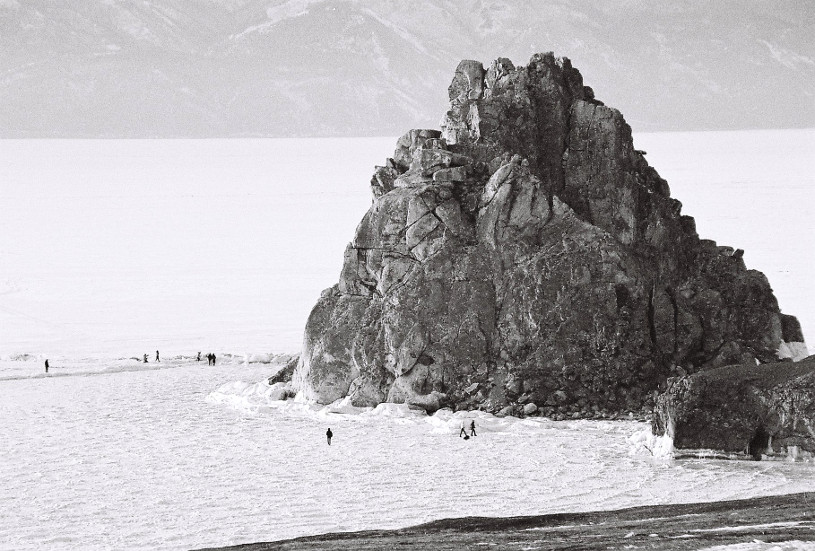
8. It’ll feel like a dream – and leave you desperate for more
When I returned home, this whole adventure felt utterly surreal. I never thought I’d go to Russia, let alone decide to complete a mini-expedition across a vast frozen lake in Siberia. More than that, it was utterly removed from anything I’d ever done. I feel like I will always be able to remember the overwhelming awe of knowing I was a tiny dot surrounded by miles of water trapped for the winter, perched atop a shelf of ice above more than 1.5km of water below. I’ll remember the bluest, clearest ice, mosaic patterns of cracks and fractures, sunsets setting the landscapes on fire each night and the pink glow of each sunrise chasing away the dark nights every morning. I’ll remember how it felt to be remote, wild, alone, the furthest I’ve ever been from other people – apart from the two friends that were with me for every step along the way.
As a first mini-expedition, I can’t recommend this enough. If you’re looking for something in extreme conditions, and an adventure to test your ability to feel utterly out of reach of rescue in a completely alien location, this should definitely be on your list. Myself and Theresa both had full time jobs when we completed this adventure, and that’s another reason I think it should go on more travellers’ lists. Whilst some explorers have completed the full length, travelling from end to end (636km), crossing the width as we did is achievable with just two weeks of leave – perfect for those with limited time or anyone looking to dip their toes into the world of expedition adventure. For me, it was an incredible adventure which has left me knowing I’m capable of so many more.
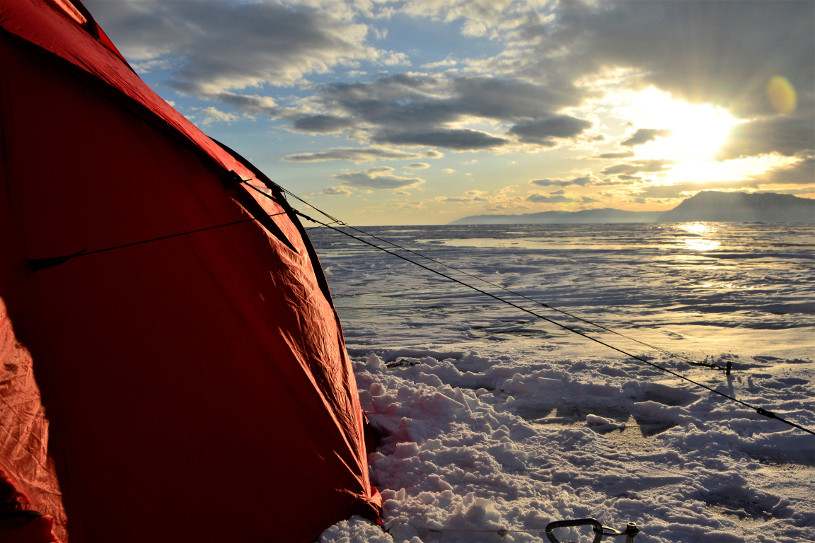
9. If you see someone post online looking for adventure buddies – take a look. And think about saying yes
Personally, I would never have had the privilege of undertaking this epic adventure if Theresa hadn’t had the resourcefulness to put it out there in the first place, and if my friend Ellie hadn’t tagged me in her post on Bex Band’s group Love Her Wild [Bex Band’s first big adventure, taking a kick scooter 150-miles around the London Loop, was funded by a Next Challenge Grant – Tim]. The latter, such a small act, led me to one of my greatest adventures of 2018. Was it perfect? Of course not. There were small arguments. We had disagreements. But I wouldn’t have asked for anything else. We tested each other in the best possible way, I learnt as much from my teammates as I did from the environment, and left knowing more about two incredible friends. It was so special to be able to take on such a journey with two fellow women adventurers – and I can’t wait to see what’s next.
[one_sixth]–[/one_sixth]
[two_third][box]
The Next Challenge Grant
Theresa, Kathryn & Ellie received equipment and advice through The Next Challenge Grant.
Do you have an adventure idea that you need help with?
[/box][/two_third]
[one_sixth_last]–[/one_sixth_last]
What do you think? Please do add your thoughts below…